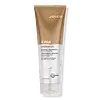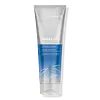What's inside
What's inside
 Key Ingredients
Key Ingredients

No key ingredients
 Benefits
Benefits

 Concerns
Concerns

 Ingredients Side-by-side
Ingredients Side-by-side

Water
Skin ConditioningCetearyl Alcohol
EmollientGlycerin
HumectantBehentrimonium Chloride
PreservativeCetyl Esters
EmollientLanolin
EmollientHydrolyzed Keratin
HumectantCocodimonium Hydroxypropyl Hydrolyzed Keratin
Skin ConditioningLaurdimonium Hydroxypropyl Hydrolyzed Keratin
Skin ConditioningHydrolyzed Keratin Pg-Propylmethylsilanediol
Skin ConditioningHydrogenated Olive Oil
Skin ConditioningOlea Europaea Fruit Oil
MaskingOlea Europaea Oil Unsaponifiables
Skin ConditioningButyrospermum Parkii Butter
Skin ConditioningArginine Hcl
Skin ConditioningPhosphatidylcholine
EmulsifyingRosa Canina Fruit Oil
EmollientAleurites Moluccanus Seed Oil
Skin ConditioningHydrolyzed Wheat Protein
Skin ConditioningPsidium Guajava Fruit Extract
AstringentAloe Barbadensis Leaf Juice
Skin ConditioningOenothera Biennis Oil
EmollientTocopheryl Acetate
AntioxidantEthylhexylglycerin
Skin ConditioningSodium Hyaluronate
HumectantGlycolipids
Skin ConditioningAmodimethicone
Isopropyl Alcohol
SolventPanthenyl Hydroxypropyl Steardimonium Chloride
Ceteareth-20
CleansingCitric Acid
BufferingTetrasodium EDTA
Trideceth-12
EmulsifyingCetrimonium Chloride
AntimicrobialBenzophenone-4
UV AbsorberHydrolyzed Wheat Starch
Skin ConditioningThioctic Acid
AntioxidantButyl Methoxydibenzoylmethane
UV AbsorberAllantoin
Skin ConditioningSodium Ascorbyl Phosphate
AntioxidantSodium Hydroxide
BufferingPhenoxyethanol
PreservativeHexyl Cinnamal
PerfumingLimonene
PerfumingBenzyl Salicylate
PerfumingParfum
MaskingWater, Cetearyl Alcohol, Glycerin, Behentrimonium Chloride, Cetyl Esters, Lanolin, Hydrolyzed Keratin, Cocodimonium Hydroxypropyl Hydrolyzed Keratin, Laurdimonium Hydroxypropyl Hydrolyzed Keratin, Hydrolyzed Keratin Pg-Propylmethylsilanediol, Hydrogenated Olive Oil, Olea Europaea Fruit Oil, Olea Europaea Oil Unsaponifiables, Butyrospermum Parkii Butter, Arginine Hcl, Phosphatidylcholine, Rosa Canina Fruit Oil, Aleurites Moluccanus Seed Oil, Hydrolyzed Wheat Protein, Psidium Guajava Fruit Extract, Aloe Barbadensis Leaf Juice, Oenothera Biennis Oil, Tocopheryl Acetate, Ethylhexylglycerin, Sodium Hyaluronate, Glycolipids, Amodimethicone, Isopropyl Alcohol, Panthenyl Hydroxypropyl Steardimonium Chloride, Ceteareth-20, Citric Acid, Tetrasodium EDTA, Trideceth-12, Cetrimonium Chloride, Benzophenone-4, Hydrolyzed Wheat Starch, Thioctic Acid, Butyl Methoxydibenzoylmethane, Allantoin, Sodium Ascorbyl Phosphate, Sodium Hydroxide, Phenoxyethanol, Hexyl Cinnamal, Limonene, Benzyl Salicylate, Parfum
Water
Skin ConditioningButylene Glycol
HumectantDimethicone
EmollientSorbitol
HumectantBehenyl Alcohol
EmollientStearyl Alcohol
EmollientBehentrimonium Chloride
PreservativeCetyl Alcohol
EmollientGlyceryl Oleate
EmollientParfum
MaskingPhenoxyethanol
PreservativeLaurdimonium Hydroxypropyl Hydrolyzed Keratin
Skin ConditioningArginine Hcl
Skin ConditioningRosa Canina Fruit Oil
EmollientSimmondsia Chinensis Seed Oil
EmollientButyrospermum Parkii Butter
Skin ConditioningOlea Europaea Fruit Oil
MaskingHydrogenated Vegetable Oil
EmollientAstrocaryum Murumuru Seed Butter
EmollientHydrolyzed Algin
Sea Water
HumectantChlorella Vulgaris Extract
Skin ConditioningPhosphatidylcholine
EmulsifyingAminopropyl Dimethicone
Glutamic Acid
HumectantStearyl Dihydroxypropyldimonium Oligosaccharides
PEG-90m
Emulsion StabilisingOctyldodecanol
EmollientSteartrimonium Chloride
PreservativePEG-6 Methyl Ether Dimethicone
EmulsifyingGlycerin
HumectantPropylene Glycol
HumectantPEG-4 Laurate
EmulsifyingTetrasodium Glutamate Diacetate
Isopropyl Alcohol
SolventSodium Hydroxide
BufferingIodopropynyl Butylcarbamate
PreservativeCitric Acid
BufferingLimonene
PerfumingBenzyl Benzoate
AntimicrobialCI 15510
Cosmetic ColorantCI 19140
Cosmetic ColorantWater, Butylene Glycol, Dimethicone, Sorbitol, Behenyl Alcohol, Stearyl Alcohol, Behentrimonium Chloride, Cetyl Alcohol, Glyceryl Oleate, Parfum, Phenoxyethanol, Laurdimonium Hydroxypropyl Hydrolyzed Keratin, Arginine Hcl, Rosa Canina Fruit Oil, Simmondsia Chinensis Seed Oil, Butyrospermum Parkii Butter, Olea Europaea Fruit Oil, Hydrogenated Vegetable Oil, Astrocaryum Murumuru Seed Butter, Hydrolyzed Algin, Sea Water, Chlorella Vulgaris Extract, Phosphatidylcholine, Aminopropyl Dimethicone, Glutamic Acid, Stearyl Dihydroxypropyldimonium Oligosaccharides, PEG-90m, Octyldodecanol, Steartrimonium Chloride, PEG-6 Methyl Ether Dimethicone, Glycerin, Propylene Glycol, PEG-4 Laurate, Tetrasodium Glutamate Diacetate, Isopropyl Alcohol, Sodium Hydroxide, Iodopropynyl Butylcarbamate, Citric Acid, Limonene, Benzyl Benzoate, CI 15510, CI 19140
Ingredients Explained
These ingredients are found in both products.
Ingredients higher up in an ingredient list are typically present in a larger amount.
We don't have a description for Arginine Hcl yet.
This ingredient is a preservative and often used for it's anti-static properties. You'll most likely see this ingredient in hair conditioners.
It does not cause irritation or sensitization in leave-on products at 1-5%.
This ingredient is also known as shea butter. It is an effective skin hydrator and emollient.
Emollients help soothe and soften your skin. It does this by creating a protective film on your skin. This barrier helps trap moisture and keeps your skin hydrated. Emollients may be effective at treating dry or itchy skin.
Shea butter is rich in antioxidants. Antioxidants help fight free-radicals, or molecules that may harm the body. It is also full of fatty acids including stearic acid and linoleic acid. These acids help replenish the skin and keep skin moisturized.
While Shea Butter has an SPF rating of about 3-4, it is not a sunscreen replacement.
Shea butter may not be fungal acne safe. We recommend speaking with a professional if you have any concerns.
Learn more about Butyrospermum Parkii ButterCitric Acid is an alpha hydroxy acid (AHA) naturally found in citrus fruits like oranges, lemons, and limes.
Like other AHAs, citric acid can exfoliate skin by breaking down the bonds that hold dead skin cells together. This helps reveal smoother and brighter skin underneath.
However, this exfoliating effect only happens at high concentrations (20%) which can be hard to find in cosmetic products.
Due to this, citric acid is usually included in small amounts as a pH adjuster. This helps keep products slightly more acidic and compatible with skin's natural pH.
In skincare formulas, citric acid can:
While it can provide some skin benefits, research shows lactic acid and glycolic acid are generally more effective and less irritating exfoliants.
Most citric acid used in skincare today is made by fermenting sugars (usually from molasses). This synthetic version is identical to the natural citrus form but easier to stabilize and use in formulations.
Read more about some other popular AHA's here:
Learn more about Citric AcidGlycerin is already naturally found in your skin. It helps moisturize and protect your skin.
A study from 2016 found glycerin to be more effective as a humectant than AHAs and hyaluronic acid.
As a humectant, it helps the skin stay hydrated by pulling moisture to your skin. The low molecular weight of glycerin allows it to pull moisture into the deeper layers of your skin.
Hydrated skin improves your skin barrier; Your skin barrier helps protect against irritants and bacteria.
Glycerin has also been found to have antimicrobial and antiviral properties. Due to these properties, glycerin is often used in wound and burn treatments.
In cosmetics, glycerin is usually derived from plants such as soybean or palm. However, it can also be sourced from animals, such as tallow or animal fat.
This ingredient is organic, colorless, odorless, and non-toxic.
Glycerin is the name for this ingredient in American English. British English uses Glycerol/Glycerine.
Learn more about GlycerinIsopropyl Alcohol is more commonly known as rubbing alcohol. It is most commonly used as a solvent, meaning it helps other ingredients dissolve.
This ingredient is an astringent alcohol. Astringent alcohols may also irritate skin as they high amounts may strip away your skin's natural oils.
Other types of astringent alcohols include:
According to the National Rosacea Society based in the US, you should be mindful of products with these alcohols in the top half of ingredients.
Any type of sanitizing product will have high amounts of alcohol to help kill bacteria and viruses.
Learn more about Isopropyl AlcoholWe don't have a description for Laurdimonium Hydroxypropyl Hydrolyzed Keratin yet.
Limonene is a fragrance that adds scent and taste to a formulation.
It's found in the peel oil of citrus fruits and other plants such as lavender and eucalyptus. The scent of limonene is generally described as "sweet citrus".
Limonene acts as an antioxidant, meaning it helps neutralize free radicals.
When exposed to air, oxidized limonene may sensitize the skin. Because of this, limonene is often avoided by people with sensitive skin.
The term 'fragrance' is not regulated in many countries. In many cases, it is up to the brand to define this term. For instance, many brands choose to label themselves as "fragrance-free" because they are not using synthetic fragrances. However, their products may still contain ingredients such as essential oils that are considered a fragrance.
Learn more about LimoneneOlea Europaea Fruit Oil is the fixed oil obtained from the ripe fruit of the Olive. In other words - olive oil.
The primary contents of olive oil are glycerides of the fatty acids linoleic, oleic and palmitic.
Olive oil also contains antioxidants such as Vitamin E. Antioxidants may help reduce signs of aging by fighting unstable free-radical molecules. It also contains Vitamins A (retinol), D, and K.
The squalene in olive oil makes it a great emollient. Emollients help soothe and soften your skin by trapping moisture in. This makes olive oil a great skin moisturizer.
Studies show olive oil to have antibacterial and antifungal properties in low concentrations. Another study found olive oil irritated sensitive oily skin. We always recommend speaking with a professional about using this ingredient in your routine.
Due to the fatty acid content, this ingredient may not be fungal-acne safe.
Learn more about Olea Europaea Fruit OilParfum is a catch-all term for an ingredient or more that is used to give a scent to products.
Also called "fragrance", this ingredient can be a blend of hundreds of chemicals or plant oils. This means every product with "fragrance" or "parfum" in the ingredients list is a different mixture.
For instance, Habanolide is a proprietary trade name for a specific aroma chemical. When used as a fragrance ingredient in cosmetics, most aroma chemicals fall under the broad labeling category of “FRAGRANCE” or “PARFUM” according to EU and US regulations.
The term 'parfum' or 'fragrance' is not regulated in many countries. In many cases, it is up to the brand to define this term.
For instance, many brands choose to label themselves as "fragrance-free" because they are not using synthetic fragrances. However, their products may still contain ingredients such as essential oils that are considered a fragrance by INCI standards.
One example is Calendula flower extract. Calendula is an essential oil that still imparts a scent or 'fragrance'.
Depending on the blend, the ingredients in the mixture can cause allergies and sensitivities on the skin. Some ingredients that are known EU allergens include linalool and citronellol.
Parfum can also be used to mask or cover an unpleasant scent.
The bottom line is: not all fragrances/parfum/ingredients are created equally. If you are worried about fragrances, we recommend taking a closer look at an ingredient. And of course, we always recommend speaking with a professional.
Learn more about ParfumPhenoxyethanol is a preservative that has germicide, antimicrobial, and aromatic properties. Studies show that phenoxyethanol can prevent microbial growth. By itself, it has a scent that is similar to that of a rose.
It's often used in formulations along with Caprylyl Glycol to preserve the shelf life of products.
Phosphatidylcholine is a type of phospholipid. Phospholipids are naturally found in our skin as they are the main component of cell membranes. Phospholipids are skin-replenishing.
This ingredient can be found in the Lecithin of soybeans.
Rosehip Oil is a non-fragrant plant oil. Rosehips are a fruit from a rose bush and are edible. This oil has skin conditioning and hydrating properties.
Rosehip contains Vitamin C, Vitamin E, fatty acids and linolenic acids. These nourish your skin barrier. Having hydrated skin may help reduce the appearance of fine-lines and wrinkles.
Another great component of Rosehip Oil is Vitamin A, or retinol. Vitamin A encourages your skin to create more collagen.
Rosehip oil may help with reducing pigmentation. The lycopene and beta-carotene have skin-lightening properties. However, more studies are needed to confirm this.
Learn more about Rosa Canina Fruit OilSodium Hydroxide is also known as lye or caustic soda. It is used to adjust the pH of products; many ingredients require a specific pH to be effective.
In small amounts, sodium hydroxide is considered safe to use. However, large amounts may cause chemical burns due to its high alkaline.
Your skin has a natural pH and acid mantle. This acid mantle helps prevent harmful bacteria from breaking through. The acid mantle also helps keep your skin hydrated.
"Alkaline" refers to a high pH level. A low pH level would be considered acidic.
Learn more about Sodium HydroxideWater. It's the most common cosmetic ingredient of all. You'll usually see it at the top of ingredient lists, meaning that it makes up the largest part of the product.
So why is it so popular? Water most often acts as a solvent - this means that it helps dissolve other ingredients into the formulation.
You'll also recognize water as that liquid we all need to stay alive. If you see this, drink a glass of water. Stay hydrated!
Learn more about Water